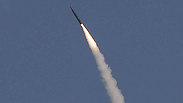
Arrow 3 missile defense test stopped at last minute
Test halted after Sparrow target missile behaves erratically, compromising safety of the test in what would have been highest altitude missile intercept ever for Israel.
In what was supposed to be the highest altitude missile test for any Israeli weapons system so far, the launching of the exoatmospheric Arrow 3 interceptor missile at Palmahim Air Force Base was canceled after the Sparrow target missile, launched into space from an F-15 fighter over the Mediterranean Sea, did not behave according to plan.
"The target did not meet the predefined safety standards and the project engineers announced 'no test,'" said a source in the defense establishment. "We will investigate why the target behaved erratically. In an interception at such an altitude, there is a high chance of debris falling and therefore safety is the highest priority."
The defense establishment is looking into the behavior of the Sparrow missile which was launched from an IAF fighter jet. The missile is supposed to act like a long-range ballistic target that could pose a threat to Israel.
The investigation of the canceled test will likely last a few weeks, and only then will a decision be made regarding further interception testing of the Arrow 3—the present model having been commissioned by the IAF early this year.
In preparations for the test, air traffic routes were altered early Monday morning. Departing flights took off facing north, parallel to Highway 6, and turned west over the Sharon region. Incoming flights began their descent north of Herzliya and flew over the Samaria mountains before landing.
Arrow 3 – intercepting Iranian missiles
The current version of the Arrow 3 is intended to take on long-range ballistic missiles, which are capable of carrying nuclear payloads, such as those currently in development in Iran.
Since being commissioned in early 2017, the Ministry of Defense, together with Israeli Aircraft Industries (IAI) and in partnership with the United States, have been working on modernizing the weapons system with the latest updates in response to any future threats emanating from the Islamic Republic.
The integration of the Arrow 3 system into the IAF completes the four-tier defense coverage of Israel: the Arrow 3 defends against exoatmospheric, long-range threats; Arrow 2 covers missiles flying within the atmosphere; David's Sling deals with medium-level threats, such as heavy rockets and unmanned aerial vehicles (UAV); and finally, the Iron Dome system defends against lower range rockets, with ranges of up to 90 km.
The Iron Dome system is also being subject to a battery of tests meant to improve its ability to deal with heavy barrages of dozens or hundreds of rockets fired simultaneously from various directions and at multiple altitudes.
In addition to these weapons systems, the older Patriot batteries are still proving useful to the Israeli Air Force, especially against the threat of enemy aircraft infiltrating Israeli airspace, such as the UAVs from Syria that have strayed over the Golan Heights.
A naval version of the Iron Dome was recently declared operational. It is meant to protect the gas drilling rigs at sea from enemy missile boats.
In March, an Arrow 2 battery successfully intercepted a Syrian anti-aircraft missile that was launched against IAF bombers attacking in Syria.











